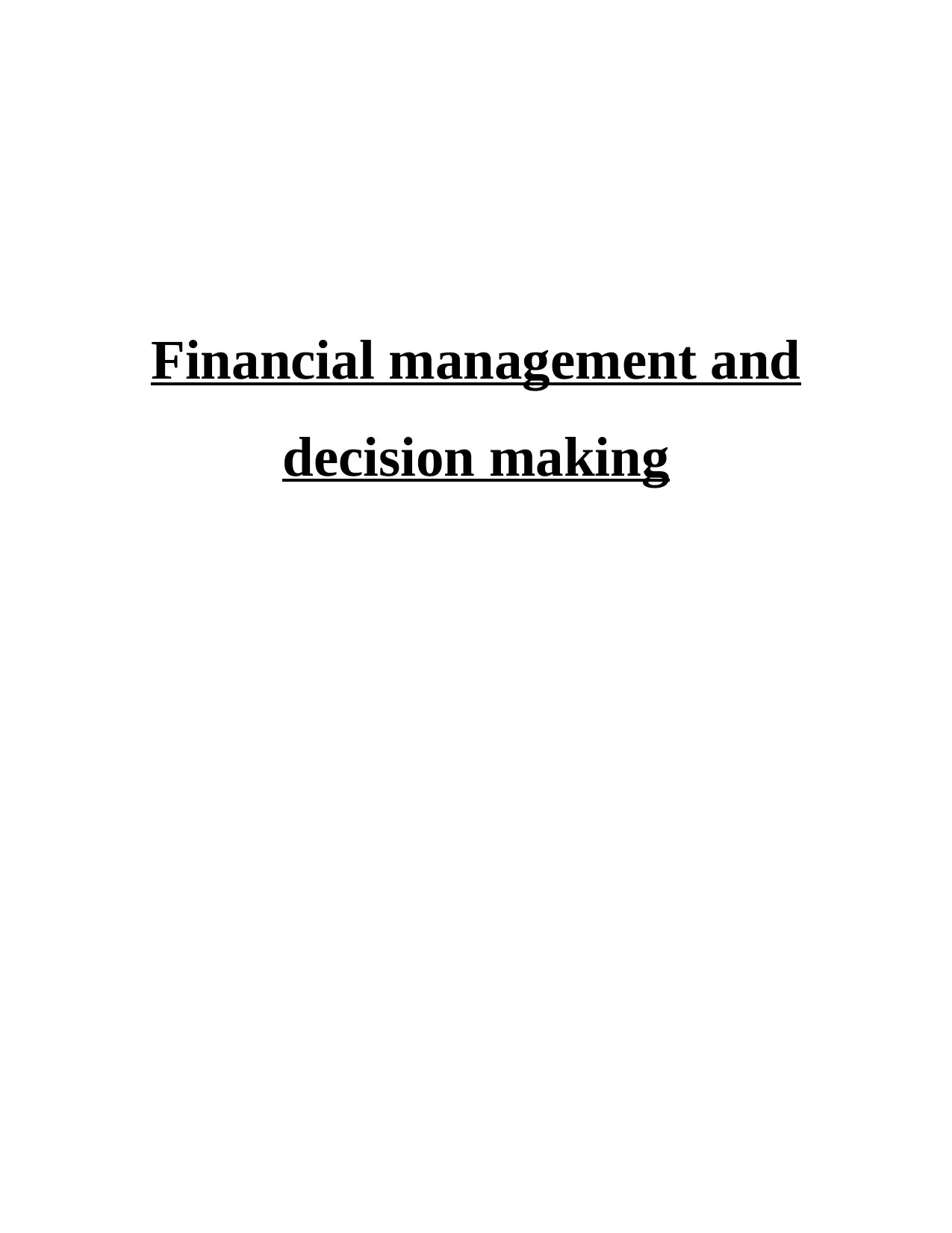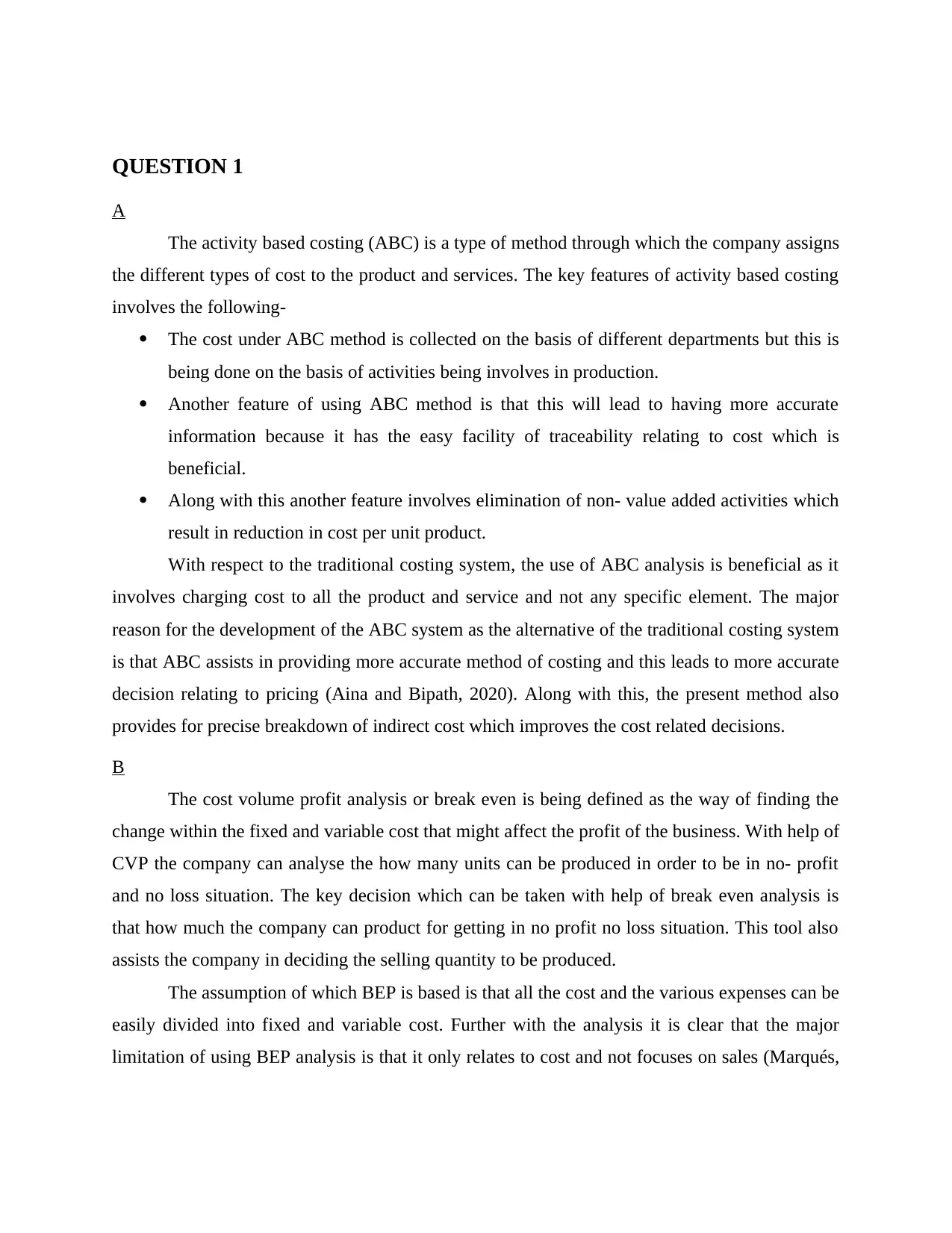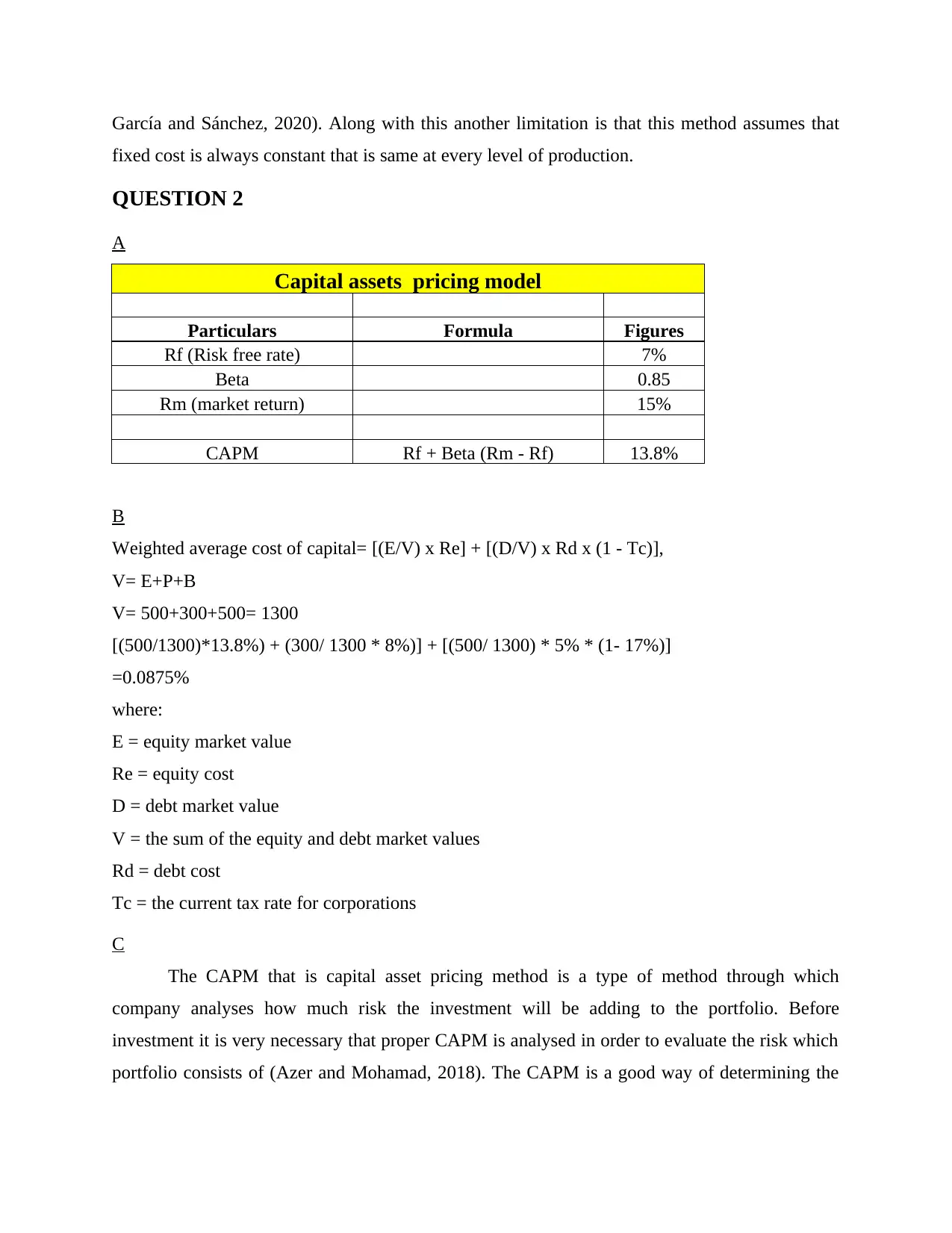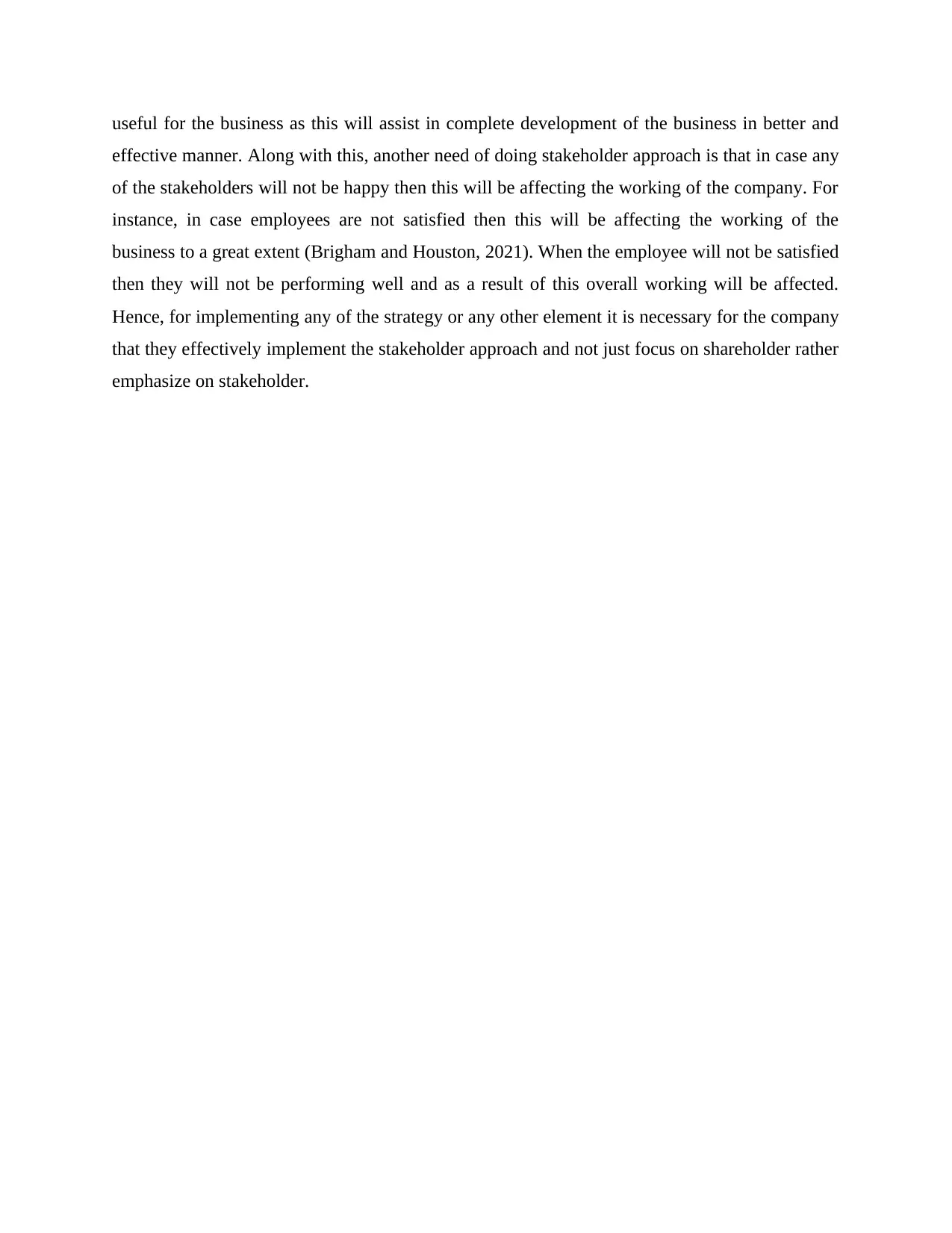Comprehensive Report on Financial Management & Decision Making
VerifiedAdded on 2023/06/18
|8
|2027
|473
Report
AI Summary
This report provides a detailed analysis of financial management and decision-making processes within businesses, covering key concepts such as activity-based costing (ABC), cost-volume-profit (CVP) analysis, and capital asset pricing model (CAPM). It explores the importance of budgeting as a control and performance management tool, contrasting traditional budgeting methods with more flexible approaches like beyond budgeting. The report also discusses principal means of finance for SMEs without stock market listing, including long-term loans, debentures, personal savings, and retained earnings. Furthermore, it emphasizes the need for a stakeholder approach in business, highlighting the importance of satisfying stakeholders to ensure the overall success and effective working of the company. The report concludes by referencing relevant books and journals to support its analysis and findings.

Financial management and
decision making
decision making
Paraphrase This Document
Need a fresh take? Get an instant paraphrase of this document with our AI Paraphraser

TABLE OF CONTENTS
QUESTION 1...................................................................................................................................3
A..................................................................................................................................................3
B..................................................................................................................................................3
QUESTION 2...................................................................................................................................4
A..................................................................................................................................................4
B..................................................................................................................................................4
C..................................................................................................................................................4
QUESTION 3...................................................................................................................................5
A..................................................................................................................................................5
B..................................................................................................................................................5
QUESTION 4...................................................................................................................................6
Principal means of finance without stock market listing............................................................6
QUESTION 5...................................................................................................................................6
Need for stakeholder approach and related factors.....................................................................6
REFERENCES................................................................................................................................8
QUESTION 1...................................................................................................................................3
A..................................................................................................................................................3
B..................................................................................................................................................3
QUESTION 2...................................................................................................................................4
A..................................................................................................................................................4
B..................................................................................................................................................4
C..................................................................................................................................................4
QUESTION 3...................................................................................................................................5
A..................................................................................................................................................5
B..................................................................................................................................................5
QUESTION 4...................................................................................................................................6
Principal means of finance without stock market listing............................................................6
QUESTION 5...................................................................................................................................6
Need for stakeholder approach and related factors.....................................................................6
REFERENCES................................................................................................................................8

QUESTION 1
A
The activity based costing (ABC) is a type of method through which the company assigns
the different types of cost to the product and services. The key features of activity based costing
involves the following-
The cost under ABC method is collected on the basis of different departments but this is
being done on the basis of activities being involves in production.
Another feature of using ABC method is that this will lead to having more accurate
information because it has the easy facility of traceability relating to cost which is
beneficial.
Along with this another feature involves elimination of non- value added activities which
result in reduction in cost per unit product.
With respect to the traditional costing system, the use of ABC analysis is beneficial as it
involves charging cost to all the product and service and not any specific element. The major
reason for the development of the ABC system as the alternative of the traditional costing system
is that ABC assists in providing more accurate method of costing and this leads to more accurate
decision relating to pricing (Aina and Bipath, 2020). Along with this, the present method also
provides for precise breakdown of indirect cost which improves the cost related decisions.
B
The cost volume profit analysis or break even is being defined as the way of finding the
change within the fixed and variable cost that might affect the profit of the business. With help of
CVP the company can analyse the how many units can be produced in order to be in no- profit
and no loss situation. The key decision which can be taken with help of break even analysis is
that how much the company can product for getting in no profit no loss situation. This tool also
assists the company in deciding the selling quantity to be produced.
The assumption of which BEP is based is that all the cost and the various expenses can be
easily divided into fixed and variable cost. Further with the analysis it is clear that the major
limitation of using BEP analysis is that it only relates to cost and not focuses on sales (Marqués,
A
The activity based costing (ABC) is a type of method through which the company assigns
the different types of cost to the product and services. The key features of activity based costing
involves the following-
The cost under ABC method is collected on the basis of different departments but this is
being done on the basis of activities being involves in production.
Another feature of using ABC method is that this will lead to having more accurate
information because it has the easy facility of traceability relating to cost which is
beneficial.
Along with this another feature involves elimination of non- value added activities which
result in reduction in cost per unit product.
With respect to the traditional costing system, the use of ABC analysis is beneficial as it
involves charging cost to all the product and service and not any specific element. The major
reason for the development of the ABC system as the alternative of the traditional costing system
is that ABC assists in providing more accurate method of costing and this leads to more accurate
decision relating to pricing (Aina and Bipath, 2020). Along with this, the present method also
provides for precise breakdown of indirect cost which improves the cost related decisions.
B
The cost volume profit analysis or break even is being defined as the way of finding the
change within the fixed and variable cost that might affect the profit of the business. With help of
CVP the company can analyse the how many units can be produced in order to be in no- profit
and no loss situation. The key decision which can be taken with help of break even analysis is
that how much the company can product for getting in no profit no loss situation. This tool also
assists the company in deciding the selling quantity to be produced.
The assumption of which BEP is based is that all the cost and the various expenses can be
easily divided into fixed and variable cost. Further with the analysis it is clear that the major
limitation of using BEP analysis is that it only relates to cost and not focuses on sales (Marqués,
⊘ This is a preview!⊘
Do you want full access?
Subscribe today to unlock all pages.

Trusted by 1+ million students worldwide

García and Sánchez, 2020). Along with this another limitation is that this method assumes that
fixed cost is always constant that is same at every level of production.
QUESTION 2
A
Capital assets pricing model
Particulars Formula Figures
Rf (Risk free rate) 7%
Beta 0.85
Rm (market return) 15%
CAPM Rf + Beta (Rm - Rf) 13.8%
B
Weighted average cost of capital= [(E/V) x Re] + [(D/V) x Rd x (1 - Tc)],
V= E+P+B
V= 500+300+500= 1300
[(500/1300)*13.8%) + (300/ 1300 * 8%)] + [(500/ 1300) * 5% * (1- 17%)]
=0.0875%
where:
E = equity market value
Re = equity cost
D = debt market value
V = the sum of the equity and debt market values
Rd = debt cost
Tc = the current tax rate for corporations
C
The CAPM that is capital asset pricing method is a type of method through which
company analyses how much risk the investment will be adding to the portfolio. Before
investment it is very necessary that proper CAPM is analysed in order to evaluate the risk which
portfolio consists of (Azer and Mohamad, 2018). The CAPM is a good way of determining the
fixed cost is always constant that is same at every level of production.
QUESTION 2
A
Capital assets pricing model
Particulars Formula Figures
Rf (Risk free rate) 7%
Beta 0.85
Rm (market return) 15%
CAPM Rf + Beta (Rm - Rf) 13.8%
B
Weighted average cost of capital= [(E/V) x Re] + [(D/V) x Rd x (1 - Tc)],
V= E+P+B
V= 500+300+500= 1300
[(500/1300)*13.8%) + (300/ 1300 * 8%)] + [(500/ 1300) * 5% * (1- 17%)]
=0.0875%
where:
E = equity market value
Re = equity cost
D = debt market value
V = the sum of the equity and debt market values
Rd = debt cost
Tc = the current tax rate for corporations
C
The CAPM that is capital asset pricing method is a type of method through which
company analyses how much risk the investment will be adding to the portfolio. Before
investment it is very necessary that proper CAPM is analysed in order to evaluate the risk which
portfolio consists of (Azer and Mohamad, 2018). The CAPM is a good way of determining the
Paraphrase This Document
Need a fresh take? Get an instant paraphrase of this document with our AI Paraphraser

cost of equity because it provides rate of return which the company pays to the equity investors.
Hence, it provides a proper cost of equity and this is beneficial for the company.
QUESTION 3
A
With the views of Humaidi and et.al., (2020) the budgeting can be used as a tool of
controlling and management of performance. The reason underlying this fact is that in case the
budgets are prepared then this provides for a better guidance to company that how they have to
manage the working. Thus, this provides as a guidance note to the employees that they have to
perform within the provided limit only.
Moreover in support of this Lichtenberg and et.al., (2018) articulates that budgeting as a
tool assist the company in forecasting the working in better manner. Hence, as a result of this the
working of the business will be improved. Also the target being set will motivate the people in
working in better manner so that the targets can be attained. In addition to this, the budgeting is
also an important tool of working because of the reason that it will help company in improving
the performance in better and effective manner.
Also, this budgeting assists the business in keeping the track of the finance in proper
manner. The reason behind this fact is that in case the finance will be properly managed then this
will improve the working efficiency of the business. Moreover, the clear communication of the
budget will assist in proper sharing of information which will help in better working.
B
The traditional budgeting may be stated as preparation of budget by keeping the past data
as the base. The various limitation of traditional budgeting system involves the following-
The major limitation of traditional budgeting is that it consumes a lot of time and
resources. This is because of the reason that first it analyses past data and then predict the future.
Along with this another limitation is that there is low change responsiveness of the
budget being prepared. This is because of the reason that fewer reviews are made and latest
things can be missed within the budget.
Along with this, the new concept of beyond budgeting that is flexible budgeting is getting
popular. Under this method of budgeting it is flexible and not fixed and depends on the changes
being taking place in external environment (Ross III and Coambs, 2018). The feature of beyond
Hence, it provides a proper cost of equity and this is beneficial for the company.
QUESTION 3
A
With the views of Humaidi and et.al., (2020) the budgeting can be used as a tool of
controlling and management of performance. The reason underlying this fact is that in case the
budgets are prepared then this provides for a better guidance to company that how they have to
manage the working. Thus, this provides as a guidance note to the employees that they have to
perform within the provided limit only.
Moreover in support of this Lichtenberg and et.al., (2018) articulates that budgeting as a
tool assist the company in forecasting the working in better manner. Hence, as a result of this the
working of the business will be improved. Also the target being set will motivate the people in
working in better manner so that the targets can be attained. In addition to this, the budgeting is
also an important tool of working because of the reason that it will help company in improving
the performance in better and effective manner.
Also, this budgeting assists the business in keeping the track of the finance in proper
manner. The reason behind this fact is that in case the finance will be properly managed then this
will improve the working efficiency of the business. Moreover, the clear communication of the
budget will assist in proper sharing of information which will help in better working.
B
The traditional budgeting may be stated as preparation of budget by keeping the past data
as the base. The various limitation of traditional budgeting system involves the following-
The major limitation of traditional budgeting is that it consumes a lot of time and
resources. This is because of the reason that first it analyses past data and then predict the future.
Along with this another limitation is that there is low change responsiveness of the
budget being prepared. This is because of the reason that fewer reviews are made and latest
things can be missed within the budget.
Along with this, the new concept of beyond budgeting that is flexible budgeting is getting
popular. Under this method of budgeting it is flexible and not fixed and depends on the changes
being taking place in external environment (Ross III and Coambs, 2018). The feature of beyond

budgeting involves the fact that is includes all the changes being taking place in the external
environment. Along with this another feature is that this type of budget can be prepared for
managing obstacles of change.
QUESTION 4
Principal means of finance without stock market listing
The finance is the most essential element for any of the company to operate and
especially for the SME. The reason underlying this fact is that SME operates at small level and it
is not necessary that it have proper finance (Musah, Gakpetor and Pomaa, 2018). The source of
finance other than listing involves the following-
Long Term loan- this is a source of finance wherein the company can borrow the money
from banks or other financial institution. Under this source of finance both the company
can borrow money and against it they have to pay some interest.
Debenture- this is another way through which both the companies can arrange finance
without listing. This is type of debt instrument which does not require any collateral and
money can be arranged without giving any ownership to the provider of money.
Personal savings- this is yet another source of finance wherein both the company can
arrange for the finance of the business. Under this method both the companies can use
their own personal saving and other money which they have with them.
Retained earnings- this is a source of finance in which the company can use the
accumulated profit of the business which they have kept aside for future use. This money
is being kept aside by the company and is being used for dealing with the future
contingencies.
QUESTION 5
Need for stakeholder approach and related factors
For the business it is very important that there is a focus on the stakeholder approach and
other factors affecting. The reason behind this fact is that in case the stakeholders will not be
satisfied then this will be affecting the working capability of the business. The stakeholders
involve each and every person who is interested in the betterment and development of the
business (Al Ahbabi and Nobanee, 2019). For the company to be successful it is necessary
stakeholder are satisfied and happy with the performance. The stakeholder approach is very
environment. Along with this another feature is that this type of budget can be prepared for
managing obstacles of change.
QUESTION 4
Principal means of finance without stock market listing
The finance is the most essential element for any of the company to operate and
especially for the SME. The reason underlying this fact is that SME operates at small level and it
is not necessary that it have proper finance (Musah, Gakpetor and Pomaa, 2018). The source of
finance other than listing involves the following-
Long Term loan- this is a source of finance wherein the company can borrow the money
from banks or other financial institution. Under this source of finance both the company
can borrow money and against it they have to pay some interest.
Debenture- this is another way through which both the companies can arrange finance
without listing. This is type of debt instrument which does not require any collateral and
money can be arranged without giving any ownership to the provider of money.
Personal savings- this is yet another source of finance wherein both the company can
arrange for the finance of the business. Under this method both the companies can use
their own personal saving and other money which they have with them.
Retained earnings- this is a source of finance in which the company can use the
accumulated profit of the business which they have kept aside for future use. This money
is being kept aside by the company and is being used for dealing with the future
contingencies.
QUESTION 5
Need for stakeholder approach and related factors
For the business it is very important that there is a focus on the stakeholder approach and
other factors affecting. The reason behind this fact is that in case the stakeholders will not be
satisfied then this will be affecting the working capability of the business. The stakeholders
involve each and every person who is interested in the betterment and development of the
business (Al Ahbabi and Nobanee, 2019). For the company to be successful it is necessary
stakeholder are satisfied and happy with the performance. The stakeholder approach is very
⊘ This is a preview!⊘
Do you want full access?
Subscribe today to unlock all pages.

Trusted by 1+ million students worldwide

useful for the business as this will assist in complete development of the business in better and
effective manner. Along with this, another need of doing stakeholder approach is that in case any
of the stakeholders will not be happy then this will be affecting the working of the company. For
instance, in case employees are not satisfied then this will be affecting the working of the
business to a great extent (Brigham and Houston, 2021). When the employee will not be satisfied
then they will not be performing well and as a result of this overall working will be affected.
Hence, for implementing any of the strategy or any other element it is necessary for the company
that they effectively implement the stakeholder approach and not just focus on shareholder rather
emphasize on stakeholder.
effective manner. Along with this, another need of doing stakeholder approach is that in case any
of the stakeholders will not be happy then this will be affecting the working of the company. For
instance, in case employees are not satisfied then this will be affecting the working of the
business to a great extent (Brigham and Houston, 2021). When the employee will not be satisfied
then they will not be performing well and as a result of this overall working will be affected.
Hence, for implementing any of the strategy or any other element it is necessary for the company
that they effectively implement the stakeholder approach and not just focus on shareholder rather
emphasize on stakeholder.
Paraphrase This Document
Need a fresh take? Get an instant paraphrase of this document with our AI Paraphraser

REFERENCES
Books and Journals
Aina, A. Y. and Bipath, K., 2020. School financial management: Insights for decision making in
public primary schools. South African Journal of Education. 40(4).
Al Ahbabi, A. R. and Nobanee, H., 2019. Conceptual building of sustainable financial
management & sustainable financial growth. Available at SSRN 3472313.
Azer, I. and Mohamad, S. A., 2018. Exploring financial management practices and problems
among students. Int. J. Acad. Res. Bus. Soc. Sci. 8. pp.2472-2477.
Brigham, E. F. and Houston, J. F., 2021. Fundamentals of financial management. Cengage
Learning.
Humaidi, A., and et.al., 2020. The Effect of Financial Technology, Demography, and Financial
Literacy on Financial Management Behavior of Productive Age in Surabaya,
Indonesia. International Journal of Advances in Scientific Research and
Engineering. 6(01). pp.77-81.
Lichtenberg, P. A., and et.al., 2018. Conceptual and empirical approaches to financial decision-
making by older adults: Results from a financial decision-making rating scale. Clinical
gerontologist. 41(1). pp.42-65.
Marqués, A. I., García, V. and Sánchez, J. S., 2020. Ranking-based MCDM models in financial
management applications: analysis and emerging challenges. Progress in Artificial
Intelligence. 9. pp.171-193.
Musah, A., Gakpetor, E. D. and Pomaa, P., 2018. Financial management practices, firm growth
and profitability of small and medium scale enterprises (SMEs). Information
management and business review. 10(3). pp.25-37.
Ross III, D. B. and Coambs, E., 2018. The impact of psychological trauma on finance: narrative
financial therapy considerations in exploring complex trauma and impaired financial
decision making. Journal of Financial Therapy. 9(2). p.4.
Books and Journals
Aina, A. Y. and Bipath, K., 2020. School financial management: Insights for decision making in
public primary schools. South African Journal of Education. 40(4).
Al Ahbabi, A. R. and Nobanee, H., 2019. Conceptual building of sustainable financial
management & sustainable financial growth. Available at SSRN 3472313.
Azer, I. and Mohamad, S. A., 2018. Exploring financial management practices and problems
among students. Int. J. Acad. Res. Bus. Soc. Sci. 8. pp.2472-2477.
Brigham, E. F. and Houston, J. F., 2021. Fundamentals of financial management. Cengage
Learning.
Humaidi, A., and et.al., 2020. The Effect of Financial Technology, Demography, and Financial
Literacy on Financial Management Behavior of Productive Age in Surabaya,
Indonesia. International Journal of Advances in Scientific Research and
Engineering. 6(01). pp.77-81.
Lichtenberg, P. A., and et.al., 2018. Conceptual and empirical approaches to financial decision-
making by older adults: Results from a financial decision-making rating scale. Clinical
gerontologist. 41(1). pp.42-65.
Marqués, A. I., García, V. and Sánchez, J. S., 2020. Ranking-based MCDM models in financial
management applications: analysis and emerging challenges. Progress in Artificial
Intelligence. 9. pp.171-193.
Musah, A., Gakpetor, E. D. and Pomaa, P., 2018. Financial management practices, firm growth
and profitability of small and medium scale enterprises (SMEs). Information
management and business review. 10(3). pp.25-37.
Ross III, D. B. and Coambs, E., 2018. The impact of psychological trauma on finance: narrative
financial therapy considerations in exploring complex trauma and impaired financial
decision making. Journal of Financial Therapy. 9(2). p.4.
1 out of 8
Related Documents
Your All-in-One AI-Powered Toolkit for Academic Success.
+13062052269
info@desklib.com
Available 24*7 on WhatsApp / Email
![[object Object]](/_next/static/media/star-bottom.7253800d.svg)
Unlock your academic potential
Copyright © 2020–2025 A2Z Services. All Rights Reserved. Developed and managed by ZUCOL.





